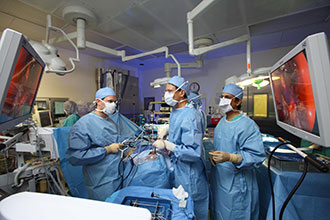Minimally invasive neurosurgery utilizes small, flexible, lighted tubes called endoscopes to visualize various parts of the brain, skull base, or spinal cord through small openings. Endoscopes serve as small microscopes, magnifying critical anatomical structures so the surgeon can easily see the various diseased areas requiring repair, removal, or replacement. Because the use of endoscopes is much less intrusive into these anatomical structures than is conventional surgery, endoscopic neurosurgery is referred to as minimally invasive neurosurgery. For example, endoscopic neurosurgery in general does not require large incisions on the scalp or skull, or extensive dissection through brain tissue. The result is a faster and simpler procedure with greatly reduced post-operative complications, faster recovery, and less pain and scarring. The actual removal or repair of the problem is done as effectively, safely, and completely as with conventional "open" surgery.
Recent technical advancements in endoscope design have produced equipment that is smaller and more efficient, with improved resolution and brighter illumination, than earlier models. Endoscopic neurosurgery has greatly simplified the management of many intracranial (within the brain) ailments in both adults and children, and has reduced surgical complications, shortened hospital stay, and minimized cosmetic concerns associated with many major neurosurgical conditions.
 Our entire faculty has advanced training in minimally invasive surgical techniques, and we use them throughout the practice, including:
Our entire faculty has advanced training in minimally invasive surgical techniques, and we use them throughout the practice, including:
Intracranial Surgery: In intracranial surgery, endoscopes are introduced into the brain through very small skull openings, following which tiny instruments may be placed through the same opening for the purpose of performing endoscopic tumor biopsy, colloid cyst resection, and endoscopic cyst fenestration, as well as to treat hydrocephalus. Operations can last from about 15 minutes to an hour, and patients are typically discharged the next day from the hospital.
Endonasal Neurosurgery: Endonasal (through the nose) neurosurgery is frequently performed to treat a range of conditions, included among which are pituitary tumors, meningiomas and chordomas. The surgeon is able to maneuver the endoscope to different areas, which allows treatment of brain tumors in different locations. The surgeon can also direct the endoscope downward and clearly see the palate and the back of the throat to operate on the top of the spine and base of the skull. Patients are typically discharged between two and four days after surgery, depending on size of the tumor and overall functioning. Find out more about minimally invasive endonasal pituitary surgery.
Spinal Surgery: Spinal surgery may also be performed endoscopically for a range of conditions affecting the spinal column, including lumbar and thoracic hernias, chronic back pain, and compression fractures, among others. Procedures for correction of these conditions include video-assisted transthoracic surgery, computer-assisted lumbar fusion, and lumbar discectomy. These may be performed under local or general anesthesia and patients often go home in as little as one day after the procedure. Find out more about Och Spine at NewYork-Presbyterian at the Weill Cornell Medicine Center for Comprehensive Spine Care.